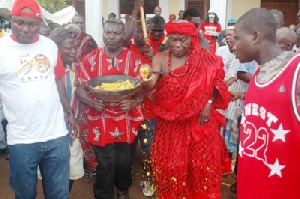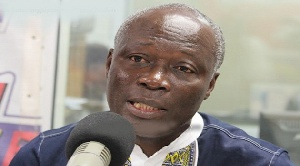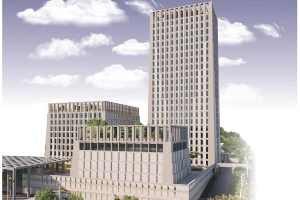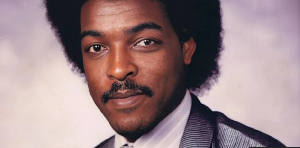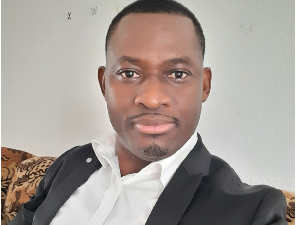1. Homowo - Accra
The Homowo festival is celebrated by the Ga’s between August and September each year. Thie unique set of Ghanaians have a history of frequent migration around Africa.
However, they are thought to have originated from from some parts of Nigeria.
The Ga’s are located on the southern coast near the Atlantic Ocean.The main festival of the Ga’s is the Homowo. Some people believe that the festival was adopted from the Jewish Passover.
However the generally accepted origin of this festival is a celebration of plentiful harvest after a very severe famine many centuries ago.The word “HOMOWO” itself is a Ga word which explicitly means “Shame to hunger.”
The Homowo festival is therefore a massive celebration of the victory over the hunger they faced. A special meal made of unfermented corn powder called “Kpokpoi” and palmnut soup of fish is the traditional meal for the festival.
During the festival, the Ga’s hoot at hunger as they eat the kpokpoi with the palm nut soup prepared from fish. Libation is poured and a symbolic meal offering is made to the gods for helping them come out of a severe period of famine and hunger.
Homowo is celebrated every year between the August and September to commemorate that day when hunger was hooted at and ridiculed. The main objective of this festival therefore is to celebrate the success story of the Ga’s in fighting famine.
2. Fetu-Afahye - Cape Coast
Cape Coast is the capital of the Central Region of Ghana.
This coastal city used to be the capital of the Gold Coast before independence. The annual festival of the people here is the Fetu Afahye which is usually celebrated on the first Saturday of September each year.
It is believed that, many years ago, there was a plague in Cape Coast. This was very pertinent and as such demanded that the people call on their gods for an intervention.
With the help of the gods, the inhabitants of Cape Coast and its environs were able to eradicate this plague, hence, the name “Fetu” originally known as “Efin Tu”- which means doing away with dirt.
The festival is also used to celebrate a bumper harvest from the sea. Rituals are performed to thank the seventy seven (77) gods of the Oguaa Traditional Area for their protection and blessing throughout the year.
As per most Ghanaian festivals, the Fetu Afahye is very colourful with drumming and dancing amidst singing of local songs and chants.
The sights and sounds from a typical Afahye is mind blowing and memorable. You simply cannot miss this.
3. Hogbetsotso - Anloga
The Hogbetsotso Festival is one of the biggest festivals in Ghana and it is celebrated by the people of Anlo in the Volta Region of Ghana.
The main theme behind this festival is a remembrance of their journey from their former home, to their present settlement in Ghana.
According to history, it is believed that before coming to their present settlement, the people of Anlo lived under a cruel and wicked ruler, King Agorkoli of Notsie, somewhere south of present day Sudan.
The people devised a way to escape from the town. They were led by a brave warrior known as the ‘’Red Hunter.’’ The town was fenced with a mud wall, so in order to soften the wall and create an escape route, the women were told to pour water on one side of the wall anytime they had to dispose off any water.
They "walked backwards" in order to confuse their pursuers and avoid being caught. Even legend has it that their leader, The Red Hunter turned himself into a rat and walk over all their footprints to make them look very old.
When they finally arrived at their present home, they celebrated the festival Hogbetsotso (Festival of Exodus) to mark this event.
The festival is a great time for the local people because it symbolizes a great time in their rich history. The festival is also a period used to settle disputes and get to know each other better.
The highlight of the Hogbetsotso Festival celebration is a grand durbar of the chiefs and people of the town. There is intense drumming and dancing and merry making. The dancing is the most fun part, with the very popular “Borborbor” dance on display.
4. Aboakyir - WInneba
Aboakyir (which basically means the catch of an animal) is the festival of the Effutus in Winneba.
Winneba is a city in the Central region and is just 35 miles west of Accra, the Capital of Ghana.
The festival is a celebration to mark the migration of the local people from the ancient Western Sudan Empire where they were led by two brothers and a god called Otu.
The main theme of the Festival is the capturing of a live deer and showcasing it on a float around the town before presenting it at a durbar.
Today, the Aboakyir festival is celebrated in May each year and is a major event in Ghana. Many tourists and people from all over the country travel there to catch a glimpse of the extraordinary ceremony amidst drumming, dancing and chanting of war songs.
5. Kundum - Axim/Takoradi
Kundum Festival is celebrated by the Coastal tribes of the Western Region of Ghana.
This festival is celebrated over a four month period at weekly intervals from town to town between August and November every year.
The main highlights of the festival are the stool cleansing, the ancestral prayers and the drumming and dancing that accompanies most Ghanaian festivals.
Kundum is an ancient festival with a modern day blend of style. The last Sunday is the grand durbar, when the final feast is prepared.
The local people distribute food accompanied by very loud drumming and dancing. It is a period of togetherness and unity as everyone comes together to make merry.
The main moral behind this celebration is to foster unity and togetherness among everybody in the city.
Many visitors and tourists troop into the region to participate in the fun and enjoyment that accompanies the festival.
If you are in Ghana around that time, you cannot afford to miss the Kundum Festival
Entertainment of Thursday, 4 February 2016
Source: jovago.com





